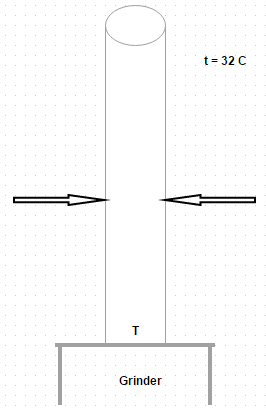MCQs
Total Questions : 75
| Page 7 of 8 pages
Answer: Option A. -> L C = L + b t/2 (b + t)
Answer: (a).L C = L + b t/2 (b + t)
Answer: (a).L C = L + b t/2 (b + t)
Answer: Option D. -> L C = L + A C/P
Answer: (d).L C = L + A C/P
Answer: (d).L C = L + A C/P
Question 63. Let us assume there are two pieces of copper wire 0.1625 cm in diameter with a device that melts it at 195 degree Celsius. The wires are positioned vertically in air at 24 degree Celsius and the heat transfer coefficient of the wire is 17 W/ square m K. Let us say k = 335W/m K i.e. of wire. Find out the energy input?

Answer: Option B. -> 2.652W
Answer: (b).2.652W
Answer: (b).2.652W
Answer: Option C. -> A C = π d²/4 and P = π d
Answer: (c).A C = π d²/4 and P = π d
Answer: (c).A C = π d²/4 and P = π d
Question 65. The figure shows a 5 cm diameter rod, 90 cm long, which is having its lower face grinded smooth. The remainder of the rod is exposed to 32 degree Celsius room air and a surface coefficient heat transfer equal to 6.8 W/m² degree exists between the rod surface and the room air. The grinder dissipates mechanical energy at the rate of 35 W. If thermal conductivity of rod material is 41.5 W/m degree, find the temperature of the rod at the point where the grinding is taking place

Answer: Option B. -> 151.45 degree celsius
Answer: (b).151.45 degree celsius
Answer: (b).151.45 degree celsius
Answer: Option D. -> 4529.4 k J/hour
Answer: (d).4529.4 k J/hour
Answer: (d).4529.4 k J/hour
Answer: Option A. -> One dimensional heat conduction
Answer: (a).One dimensional heat conduction
Answer: (a).One dimensional heat conduction
Answer: Option C. -> Maximum lateral surface at the root side of fin
Answer: (c).Maximum lateral surface at the root side of fin
Answer: (c).Maximum lateral surface at the root side of fin
Answer: Option B. -> 3.658 W
Answer: (b).3.658 W
Answer: (b).3.658 W
Answer: Option D. -> Surface area is maximum to promote the rate of heat transfer
Answer: (d).Surface area is maximum to promote the rate of heat transfer
Answer: (d).Surface area is maximum to promote the rate of heat transfer
















